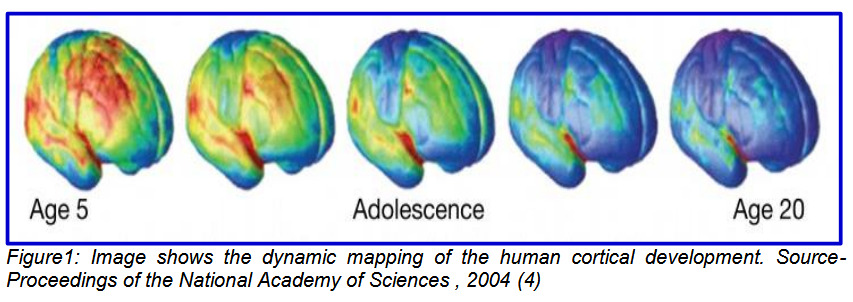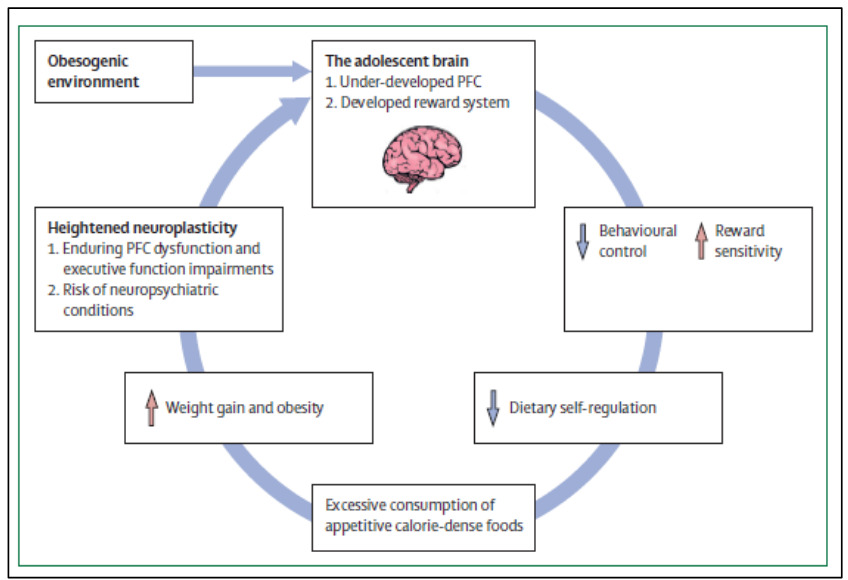
The tussle between the developing adolescent brain and dietary choices: who’s the target who’s the trigger?
Abstract
Teen brain health and dietary choices comprise an interesting read for all. The adolescent brain is not completely developed and these underdeveloped structures largely influence behavior, cognition and dietary controls. The current article describes the unique complimentary relation between teen brain development and dietary choices. The developing teen brain is characterized by underdeveloped decision-making capabilities, heightened reward system and limited restraint which compels them to eat poorly and in turn negatively impacts the normal functioning of the neurological processes. Immature regulatory processes and underdeveloped prefrontal cortex trigger an urge to consume a calorie rich diet. In turn diet is a crucial environmental factor that affects the overall brain development. A calorie rich diet has a negative impact on the structure and function of the prefrontal cortex leading to altered signaling and neurotransmitter systems. Thus it is important to understand the neuroscience underlying the erratic and impulsive eating behavior prevalent in teenagers all across the world. Obesity is only one of the obvious external indicators of poor health observed in adolescents however, the damage is much deeper. If not corrected timely, unhealthy dietary choices can have a long lasting and irreversible negative impact on the overall brain health.
Key words: adolescent brain, dietary choices, prefrontal cortex, teen brain health.
Introduction :
“I am a grown now and can take my own decisions”, well if you have heard this statement before you have definitely encountered the teenage or a teenager. A simple phrase that reflects the crucial phase of adolescence when kids are no longer behaving like kids and adulating is still far away. Parenting a teenager is a herculean task because this transition phase is marked by impulsive behavior, hormonal changes, mood swings and most importantly eating disorders. Fast food joints and cafes have thrived at the expense of the ever hungry teenagers who are constantly binging on burger, pizza, pasta, fries, aerated drinks and all things conventionally deemed unhealthy. Working mothers who have teenage kids are constantly worried when their children are at home in close proximity to the refrigerator. It is often said in good humor, ‘protect your kitchen from the teen locusts’ that shall eat away all the cake and goodies to satisfy their never ending food cravings. These cravings and dietary habits are associated with adolescence which is broadly termed as the developmental period that begins with the onset of puberty and ends with the onset of adulthood.
The World Health Organization defines adolescence as the period spanning between the ages of 10 upto19 years. However, many argue that this period is prolonged up till early 20s due to continued physical and neurobiological development. This period is marked by heightened psychological plasticity and rapid growth which makes the adolescent susceptible to various health risks and behavioral abnormalities. Healthy dietary practice requires stringent regulatory processes which help in curbing the urge to consume calorie dense and highly palatable foods. In one of our previous articles entitled ‘Over Indulgence in Fast Food Comes with a Price: It Can Cost You Your Vision’ we had discussed the relevance of brain development during adolescence and how the prematurely developed prefrontal cortex affects addictions, erratic behavior and dietary habits.
The prefrontal cortex is an area of the brain which is responsible for self-regulation and does not mature until our early 20’s. This is directly linked with the underdeveloped regulatory processes which are imperative in governing decision making and dietary behavior. In this article we shall discuss the highlights of an important study by a group of researchers, namely Cassandra Lowe, J. Bruce Morton and Amy Reichelt published in ‘The Lancet Child & Adolescent Health’(1). The article traces the dual susceptibility of the developing teen brain with underdeveloped decision-making capabilities, heightened reward system and limited restraint which compels them to eat poorly and in turn negatively impacts the normal functioning of the neurological processes.
Understanding the intricate balance between adolescent brain development and diet
Adolescence is a period marked by continued neuroplasticity and psychological development. The brain undergoes extensive functional and neurobiological remodeling predominantly in regions responsible for reward seeking and behavioral control, namely dopaminergic reward pathways and the prefrontal cortex. The developing adolescent brain is responsible for facilitating planning, reasoning, impulse control and cognitive flexibility.
Brain development is often influenced by the environment in a process known as experience dependent neuroplasticity that helps in shaping the development of neurocircuits by local remodelling. This involves the dynamic reorganization of brain functions and structures in response to environmental inputs. The presynaptic and postsynaptic neuronal connections are strengthened by environmental stimuli in a process called long-term potentiation. Repetitive exposure to the same environmental stimuli and experience stabilizes the neuronal connections and further influences dendritic and axonal growth patterns. Further neurotransmitters such as dopamine play a role in modulating inter-individual variability in cognitive abilities and functional activation patterns and neuroplasticity (2). Diet is one such crucial environmental factor that affects the developing brain. It is further documented that individual differences in lateral prefrontal cortex input are responsible for triggering a drive for the over consumption of hyperpalatable calorie-dense foods. This calorie rich diet has a negative impact on the structure and function of the prefrontal cortex leading to altered dopamine signaling and inhibitory neurotransmitter systems within this area of the brain (1). This eventually causes an impaired cognitive control further driving the excessive and persistent intake of hyper-palatable calorie dense foods. Therefore diet and development are linked intricately in such a way that they mutually impact each other. Since developmental studies are ethically challenging to be carried out in human beings majority of the data is generated on the rodent models. Similarly research has shown that when rodents are fed on a calorie dense diet during their developmental stages (equivalent to the adolescent stage in humans) it had a persuasive functional effect on the brain causing severe deficits in learning, memory and cognitive control (3). Figure 1 shows the time lapse images of the cortical development in humans from age 5 up till age 20.

Figure1: Image shows the dynamic mapping of the human cortical development. Source :Proceedings of the National Academy of Sciences , 2004 (4)
This period of adolescence is characterized by heightened emotionality where the reward drive is greater as compared to the cognitive control. It is also a stage where the limbic regions reach maturity while the prefrontal cortex is still developing. This difference in the maturation times creates an imbalance between top-down cognitive regulation (from the prefrontal cortex) and the reward-driven behaviors (limbic system), which is manifested as augmented sensitivity to rewards and diminished behavioral regulation. The underdeveloped connectivity between the amygdale (a key node of the limbic system) and the prefrontal cortex during adolescence is responsible for the low behavioral regulation in rodents and humans (5). This imbalance between top-down regulatory regions and subcortical regions might trigger excessive consumptive behaviors, motivated by food rewards, binge eating and emotional eating which are the major risk factors for obesity.

Figure 2: Diagrammatic impact of the obesogenic environment on the developing adolescent brain. Source: The Lancet Child & Adolescent Health, 2020 (1)
The increased level of food consumption in teenagers can be attributed to the elevated metabolic activity leading to rapid development and physical growth that comes with puberty. These developmental changes include gain in fat mass in female adolescents and muscle mass in male adolescents. Rapid growth is observed across species, whereby adolescent rats have shown the highest caloric intake during this period relative to their bodyweight. It is observed that increased metabolic activity can partially accommodate for excessive caloric load from high fat diets without the considerable weight gain in teenagers, therefore adolescence might provide partial protection against developmental obesity. However, behavioural habits such as diet acquired during adolescence might potentiate overconsumption of calorie-dense foods into adulthood, as the health consequences might not be immediately apparent (1). Thus weight gain alone is not an indicator of bad health instead it’s the overall quality of diet that needs to be considered for the development of the teen brains. Figure 2 summarizes the effect of a calorie rich diet on the developing adolescent brain.
Concluding remarks
Discussing teen brain health and the effect of diet is a never ending topic which has intrigued researchers, medical practitioners and health experts. We have made a small effort through this article to highlight the relevance of dietary choices during the growing up years and how they affect the adolescent brain development. Diet and brain development are linked in a way that both influence the effect of the other. Neuroscience has often given us crucial leads in cases where normal medical explanations fail. No doubt brain is one of the most complex organs of our body and will continue to intrigue neuroscientists even in times to come. Every human behavior and action can be explained if we delve at the root cause of the problem and investigate it from a scientist’s perspective. Next time you feel agitated at a teenager for not behaving like a responsible adult do reflect at the possibility of an amateur teen brain that is still developing. It is the responsibility of every parent to understand that adolescents need to be handled with care because they themselves are not completely aware of the biological changes affecting their growth and mental well being. At the same time it is important to ensure that adolescents understand the detrimental effects of calorie dense foods that can harm and even permanently damage their brain growth. Obesity is only a superficial problem that is associated with an unhealthy diet but the problems associated with fat and sugar rich food are deeper and irreversible. Exercise, dietary control and self-discipline are the most effective ways of ensuring a healthy growth during adolescence. Next time your teenage kid insists on gorging his favorite piece of junk food, do not lose your cool instead give him a small dose of neuroscience.
References
1. Lowe CJ, Morton JB, & Reichelt AC. Adolescent obesity and dietary decision making—a brain-health perspective. The Lancet Child & Adolescent Health. (2020), https://doi.org/10.1016/S2352- 4642(19)30404-3
2. Reichelt AC. Adolescent maturational transitions in the prefrontal cortex and dopamine signaling as a risk factor for the development of obesity and high fat/high sugar diet induced cognitive deficits. Frontiers in behavioral neuroscience. Oct13;10:189. eCollection (2016), doi: 10.3389/fnbeh.2016.00189
3. Labouesse MA, et al. Hypervulnerability of the adolescent prefrontal cortex to nutritional stress via reelin deficiency. Molecular Psychiatry 22(7):961-971, (2017), doi: https://doi.org/10.1038/mp.2016.193
4. Gogtay N, et al. Dynamic mapping of human cortical development during childhood through early adulthood. Proceedings of the National Academy of Sciences 101(21):8174-8179, (2004), https://doi.org/10.1073/pnas.0402680101
5. Gee DG, et al. A developmental shift from positive to negative connectivity in human amygdala–prefrontal circuitry. Journal of Neuroscience 33(10):4584-4593. (2013), DOI: 10.1523/JNEUROSCI.3446- 12.2013